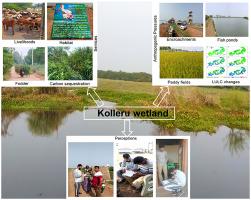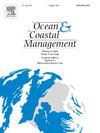Trade-offs in ecosystem services of a Ramsar wetland due to conversion into aquaculture ponds in the coastal region of Indian peninsula
IF 5.4
2区 环境科学与生态学
Q1 OCEANOGRAPHY
引用次数: 0
Abstract
The conversion of coastal wetlands into aquaculture ponds is a common practice in South-East Asia, yet there lies a significant gap in analyzing its impacts on the delivery of ecosystem services. This study integrates multiple datasets to assess trade-offs in ecosystem services of a Ramsar wetland due to its conversion into aquaculture ponds in the coastal region of Indian peninsula. Local perceptions of ecosystem services and attitudes toward the Kolleru wetland were gathered using a standardized questionnaire, while land system changes from 1975 to 2023 were analyzed using Landsat imagery. The findings indicate that Kolleru wetland provides numerous ecosystem services ranging from local to global significance. The wetland functions as a vital habitat for migratory waterfowl including threatened species and serves as a natural buffer against floods and storm surges in the coastal area. Socioeconomic assessments revealed that the Kolleru wetland supports livelihoods by supplying fish, food, fodder, and medicinal plants. Chi-square (χ2) analysis showed that perceptions and attitudes are strongly influenced by educational background and patterns of resource use (χ2 = 4614.3, p =< 2.2e−16). The respondents perceived greater monetary benefits to fishponds (11488.5 million USD/yr) and paddy fields (0.58 million USD/yr) compared to the natural wetland. Nevertheless, the intact wetland delivers a variety of provisioning, regulating, supporting, and cultural services. Land use land cover analysis revealed a dramatic shift, with aquaculture expanding from 10% of the wetland area in 1990 to 57% in 2023. This transformation has led to significant trade-offs in ecosystem services, including habitat loss for migratory birds, disruption of water flow, and reduced flood storage capacity. The study emphasizes the need for effective management strategies that balance wetland conservation with the socioeconomic needs of local communities.

印度半岛沿海地区拉姆萨尔湿地转变为水产养殖池塘对生态系统服务的权衡
将沿海湿地转变为水产养殖池塘是东南亚的一种普遍做法,但在分析其对提供生态系统服务的影响方面存在重大差距。本研究整合了多个数据集,以评估印度半岛沿海地区拉姆萨尔湿地因转变为水产养殖池塘而对生态系统服务的权衡。通过标准化问卷收集了当地对科勒鲁湿地生态系统服务的看法和态度,并利用Landsat图像分析了1975 - 2023年土地系统的变化。研究结果表明,科勒鲁湿地提供了多种生态系统服务,从当地到全球都具有重要意义。该湿地是包括濒危物种在内的迁徙水禽的重要栖息地,也是沿海地区抵御洪水和风暴潮的天然缓冲区。社会经济评估显示,Kolleru湿地通过提供鱼类、食物、饲料和药用植物来支持生计。卡方(χ2)分析显示,教育背景和资源利用模式对认知和态度有很大影响(χ2 = 4614.3, p =<;2.2 e−16)。受访者认为,与自然湿地相比,鱼塘(11.488亿美元/年)和稻田(0.58亿美元/年)的经济效益更大。然而,完整的湿地提供了各种供给、调节、支持和文化服务。土地利用和土地覆盖分析显示了巨大的变化,水产养殖从1990年占湿地面积的10%扩大到2023年的57%。这种转变导致了生态系统服务的重大权衡,包括候鸟栖息地的丧失、水流的中断和洪水储存能力的降低。该研究强调需要有效的管理策略来平衡湿地保护与当地社区的社会经济需求。
本文章由计算机程序翻译,如有差异,请以英文原文为准。
求助全文
约1分钟内获得全文
求助全文
来源期刊

Ocean & Coastal Management
环境科学-海洋学
CiteScore
8.50
自引率
15.20%
发文量
321
审稿时长
60 days
期刊介绍:
Ocean & Coastal Management is the leading international journal dedicated to the study of all aspects of ocean and coastal management from the global to local levels.
We publish rigorously peer-reviewed manuscripts from all disciplines, and inter-/trans-disciplinary and co-designed research, but all submissions must make clear the relevance to management and/or governance issues relevant to the sustainable development and conservation of oceans and coasts.
Comparative studies (from sub-national to trans-national cases, and other management / policy arenas) are encouraged, as are studies that critically assess current management practices and governance approaches. Submissions involving robust analysis, development of theory, and improvement of management practice are especially welcome.
 求助内容:
求助内容: 应助结果提醒方式:
应助结果提醒方式:


